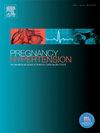The P4 Study: 6 months postpartum body composition in normotensive vs hypertensive pregnancies
IF 2.9
4区 医学
Q2 OBSTETRICS & GYNECOLOGY
Pregnancy Hypertension-An International Journal of Womens Cardiovascular Health
Pub Date : 2025-08-15
DOI:10.1016/j.preghy.2025.101249
引用次数: 0
Abstract
Objectives
Increased postpartum weight retention, a risk factor for long-term obesity and cardiometabolic diseases, is greater following hypertensive disorders of pregnancy (HDP), possibly mediated by body composition (BC) changes. However, normative postpartum BC data are lacking. This study aimed to: (1) construct a reference range for BC in normotensive women 6 months postpartum for Caucasian and Asian populations, (2) compare BC 6 months postpartum between women who had a normotensive pregnancy (NP), gestational hypertension (GH) and preeclampsia (PE) in pregnancy, and (3) explore predictors of postpartum BC.
Study design
Cross-sectional analysis 6 months postpartum from the Postpartum, Physiology, Psychology and Paediatrics (P4) prospective cohort study of women after NP, GH and PE.
Main outcome measures
The main BC measures were body fat percentage (BF%), fat mass, adipose tissue mass, lean tissue mass, and relative lean tissue mass determined using bio-impedance analysis at 6 months postpartum.
Results
388 women were included: 280 NP, 21 GH, 87 PE. 10th–90th percentile range for BF% was 24–47 % amongst all NP women, 24–47 % for Caucasian, and 21–44 % for Asian (p = 0.016). Average postpartum BF% was highest after GH (44 ± 7 %), followed by PE (39 ± 9 %) and NP (36 ± 9 %) [p < 0.001]. Significant predictors of higher postpartum BF% were HDP, Caucasian ethnicity, gestational diabetes mellitus, higher antenatal Edinburgh Depression Scale (EDS) score, and breastfeeding cessation by 6 months.
Conclusion
A postpartum BC reference range for NP, which differs between Caucasian and Asian women, was established. Experiencing HDP was independently associated with increased postpartum BF%, which may contribute to longer-term obesity and cardiometabolic risks.
P4研究:正常妊娠与高血压妊娠的产后6个月身体组成
妊娠期高血压疾病(HDP)后,产后体重潴留增加是长期肥胖和心脏代谢疾病的危险因素,可能是由身体成分(BC)改变介导的。然而,缺乏规范的产后BC数据。本研究旨在:(1)建立高加索和亚洲人群产后6个月血压正常妇女BC的参考范围;(2)比较妊娠期血压正常(NP)、妊娠期高血压(GH)和先兆子痫(PE)妇女产后6个月的BC;(3)探讨产后BC的预测因素。研究设计横断面分析:产后6个月,产后,生理,心理和儿科(P4)前瞻性队列研究的妇女NP, GH和PE。主要预后指标主要的BC指标为产后6个月时用生物阻抗分析法测定的体脂率(BF%)、脂肪质量、脂肪组织质量、瘦组织质量和相对瘦组织质量。结果共纳入388例女性:NP 280例,GH 21例,PE 87例。在所有NP女性中,BF%的第10 - 90百分位数范围为24 - 47%,白种人为24 - 47%,亚洲人为21 - 44% (p = 0.016)。GH后平均产后BF%最高(44±7%),其次为PE(39±9%)和NP(36±9%)[p <;0.001]。产后BF%较高的显著预测因子为HDP、高加索人种、妊娠糖尿病、产前爱丁堡抑郁量表(EDS)评分较高和6个月停止母乳喂养。结论建立了白种人与亚洲女性产后乳腺癌NP的参考范围。经历HDP与产后BF%增加独立相关,这可能导致长期肥胖和心脏代谢风险。
本文章由计算机程序翻译,如有差异,请以英文原文为准。
求助全文
约1分钟内获得全文
求助全文
来源期刊

Pregnancy Hypertension-An International Journal of Womens Cardiovascular Health
OBSTETRICS & GYNECOLOGYPERIPHERAL VASCULAR-PERIPHERAL VASCULAR DISEASE
CiteScore
4.90
自引率
0.00%
发文量
127
期刊介绍:
Pregnancy Hypertension: An International Journal of Women''s Cardiovascular Health aims to stimulate research in the field of hypertension in pregnancy, disseminate the useful results of such research, and advance education in the field.
We publish articles pertaining to human and animal blood pressure during gestation, hypertension during gestation including physiology of circulatory control, pathophysiology, methodology, therapy or any other material relevant to the relationship between elevated blood pressure and pregnancy. The subtitle reflects the wider aspects of studying hypertension in pregnancy thus we also publish articles on in utero programming, nutrition, long term effects of hypertension in pregnancy on cardiovascular health and other research that helps our understanding of the etiology or consequences of hypertension in pregnancy. Case reports are not published unless of exceptional/outstanding importance to the field.
 求助内容:
求助内容: 应助结果提醒方式:
应助结果提醒方式:


